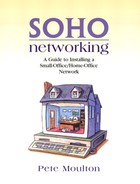Key Technical Terms
10 Base T— 10 Mbps baseband (digital) half-duplex transmission over unshielded twisted pair wire.
100 Base TX— 100 Mbps baseband (digital) full-duplex transmission over unshielded twisted pair wire.
CAT-3— A common type of unshielded twisted pair wire used for analog telephones and early LANs that ran at 10 Mbps.
CAT-5— The most common type of unshielded twisted pair wire used for LANs that run at 10 Mbps and 100 Mbps.
Celeron— A cheap Intel CPU chip that is equivalent to the Pentium II.
DDR— Double data rate DRAM is a new type of RAM that is twice as fast as SDRAM.
DIMM— Dual inline memory modules; the mounting package for SDRAM.
ECC— Error-correcting circuitry corrects RAM memory and other memory errors.
Firewall— A network component that secures a network from the public Internet. Firewalls filter incoming and outgoing traffic to detect intrusions, stop access to unauthorized Web sites, and hide the network from hackers.
Hub— A networking component connecting PC hosts together. This component typically performs the repeater function.
IDE— Integrated drive electronics is the most common fixed disk drive interface. IDE drives are the least expensive disk drives.
ISO seven-layer networking model— An international standard that divides networking functions among seven layers. These layers are Layer 1—physical, Layer 2—data link, Layer 3—network, Layer 4—transport, Layer 5—session, Layer 6—presentation, and Layer 7—application.
MOD-8— The designation for a modular 8-pin connector more commonly called an RJ-45 connector.
NETBEUI— Network Basic Input/output System Extended User Interface is a Windows protocol layer that is used in simple peer-to-peer LANs.
NetWare— Novell's server software that implements client/server networks.
NOS— Network Operating System is what Novell calls NetWare.
Pentium— An Intel CPU chip that implements the i386 or 32-bit CPU architecture.
PING— Packet Internet (Inter-Network) Groper is a command that tests for active IP addresses.
RAM— Random access memory is the volatile working memory of a PC host.
RDRAM— Rambus DRAM is the RAM type used with Pentium 4 CPU chips.
Router— A networking component connecting one network to another. This component typically represents one LAN to another LAN as a single IP address.
SAN— Storage Area Network is a network that connects storage systems and represents them to a server as a single disk drive. They are used in large networks.
SDRAM— Synchronous Dynamic RAM is a common memory chip.
Servers— A networking component providing disk sharing, print sharing, and application processing services to PC hosts. They are the server side of a client/server network.
SIMD— Single Instruction Multiple Data is a special instruction set extension in Intel Pentium III chips.
SPX/IPX— Sequenced Packet Exchange/Internet Packet Exchange is Novell's protocol layer software equivalent to TCP/IP.
SQL— Structured Query Language is software used to develop database applications.
Switch— A networking component connecting PC hosts together. This component improves LAN performance by connecting PC hosts directly to one another as though they were on a separate network.
TIA/EIA— Telecommunications Industry Association/Electronic Industries Association.
UNIX— An open source code operating system originally developed by Bell Labs. Linux is a variation of UNIX that runs on PC hosts. UNIX is used on many Internet servers.
UTP— Unshielded twisted pair wire has solid copper wire twisted into several individual pairs.
Xeon— An Intel CPU chip used in servers because of large internal cache memory.
